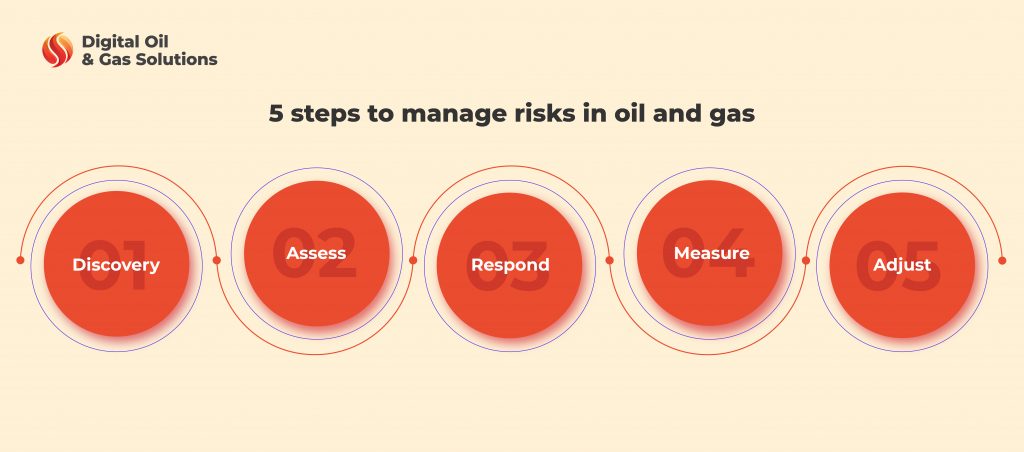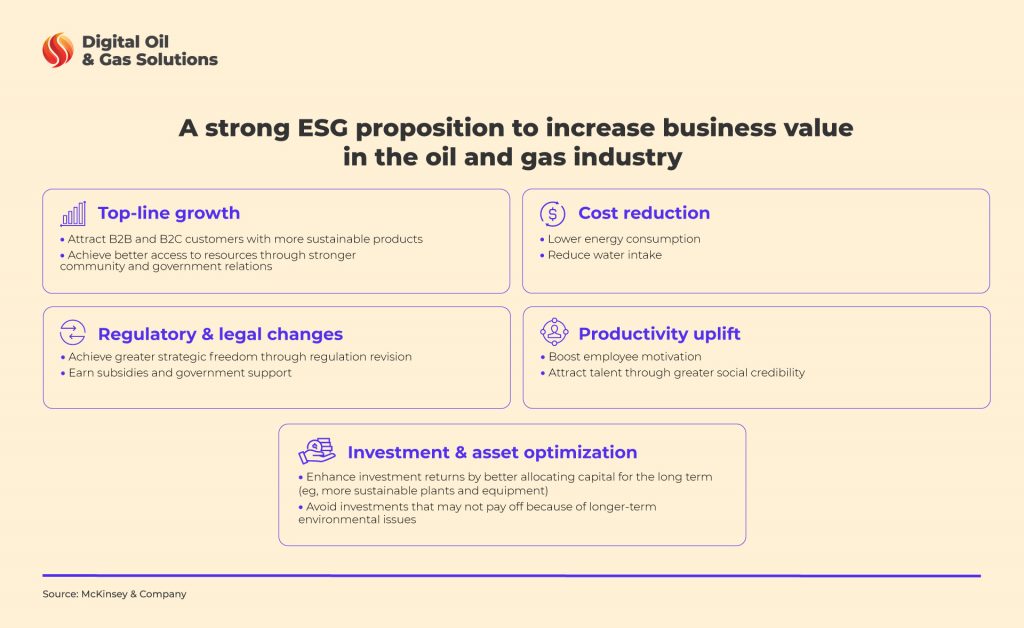Modern digital solutions that use data analytics can yield critical value and create innovative use cases, helping c-level management drive a proactive oil and gas business model. How is that possible and what are the outcomes? Let’s explore together.
A proactive approach to oil and gas business operations: definition, strengths, and traits
This methodology entails looking for new business opportunities, taking preventive measures against potential disruptions, and planning strategically for the company’s future. Proactive oil and gas leadership works on identifying and solving issues before they expand or even happen. They discover and evaluate risks and then take steps to mitigate them or turn them into business growth.
Such a business model for oil and gas industry strategy is beneficial because it gives you the freedom to consider several options and decide rather than merely responding out of necessity to a situation that already may be out of control. By doing so, your company will have better chances of addressing challenges with minimal effect on business.
Top 6 business processes driven by proactive company management
1. Review the state of each organization’s data
Making quick repairs or applying run-to-failure programs seems practical and cost-effective until you see a huge bill to urgently fix critical assets that have broken down. Leadership in oil and gas investing time and resources in preventive maintenance can considerably decrease the likelihood of downtime and extend the life of assets. Frequently servicing machinery allows you to run it longer and more proficiently, substantially cutting the cost of operating equipment and increasing the value of assets.
Advanced remote technology for machinery monitoring and diagnostics support a proactive oil and gas business model and facilitate decision-making. You can perform a remote survey, track all the information on assets around the clock, and effectively deal with any potential problem.
2. Risk management
Today’s leadership in the oil and gas industry encounters intensifying challenges: oil price volatility from the Russia-Ukraine crisis, political unrest, and low demand for fossil fuels. Proactive risk management enhances business ability to handle existing and emerging risks and helps you adjust quickly to crises. Being a forward-thinking oil and gas sector leader is difficult and requires a thorough situation analysis, risk likelihood assessment and prioritization, and comprehensive plan development. Mapping out possible scenarios with contingency roadmaps can help you stay in control no matter what.


3. Safety culture
Although accidents are usually unpredictable, building a proactive safety culture decreases an accident’s probability and makes dealing with it more seamless. This approach can lower staff turnover and training costs, reduce absenteeism and possible insurance claims, decrease the frequency of workplace accidents, and positively affect your business reputation. By doing so, oil and gas leadership figures will show workers and the public that they put people’s welfare above all.
Moreover, real-time data at hand would allow you to rapidly analyze risks, mitigate, and automatically monitor them to ensure they are working. This is becoming a reality thanks to connected digital ecosystems that collect risk data and transform it into actionable insights.
4. Decision-making and problem solving
Successfully dealing with issues entails developing an emergency action program and crisis management strategy to constantly uncover and solve problems quickly and effectively. Anticipating possible challenges and preventing them is vital to ensure any business continuity. A prudent industry leader in oil and gas should examine data and incident reports to evaluate activities, discover trends and patterns, and make practical decisions.
Organizations that built a solid foundation in the good times are in an excellent position to weather any challenges or crises. Thus, senior oil and gas leadership can make rapid and informed decisions to minimize disorientation and redirect everyone’s effort in a clearly defined way.
5. ESG commitments
A proactive oil and gas business model in ESG strategy means going the extra mile beyond those required by regulation. With a field data capture solution, you can monitor EHS and greenhouse indicators that will help to implement sustainable corporate social responsibility policies and ESG initiatives. ESG-focused investing now exceeds 21.5 billion, increasing the urgency for late adopters to join the ESG movement or risk being left behind.


6. Talent acquisition
Given the fundamental labor market shifts, unprecedented skill gaps, and emerging oil and gas talent trends, more companies are building a talent pipeline. They think ahead to what skills will be needed in the future and interact with candidates who possess those skills. Proactive oil and gas leadership gathers potential talents, including those not actively looking for a new role, and keeps them as reserves for possible future positions. This approach will bring benefits such as good-fit candidates, reduced recruitment time, and improved candidate experience.
4 tips to create and implement a proactive oil and gas business model
- Analyze internal workflows. You should re-examine your processes to discover those you can improve. Digitalization in oil and gas can decrease the dependence on certain work routines, remove manual tasks, and make operations more efficient. If you can automate a process with some software, do it. The more useless procedures you remove, the more time you’ll have to get back to effective and realistic planning.
- Upgrade corporate culture. The reactive management style is sometimes so much a part of a company culture that it could feel counterintuitive to contradict the established flow. To create a culture filled with proactivity, an oil and gas leader should show that they value employees’ input, hear their ideas, and are willing to pursue them. Doing so will awaken greater enthusiasm to modernize. By showing your support of a creative environment, you’ll encourage employees to be more active in their jobs and problem-solving.
- Use data analytics. The ability of a business to analyze and make meaningful interpretations of data is crucial for creating workable proactive strategies and leadership styles for oil and gas industry. Consider the main areas of concern, information about competitors, regulations, and development trends to accurately assess the current state. Investing in modern tools like data analytics platforms will provide you visibility on assets and empower you to gain better insights from data. With these insights, you will more easily detect opportunities, identify patterns and trends to take the right actions, and achieve desired outcomes.
- eep an eye on the horizon. Today, one of the main traits of business model for oil and gas industry success is strategic thinking about the future and simultaneous focus on running a company profitably. So, make time for planning and looking out for groundbreaking technologies. Consider how these digital solutions will affect your business and how your company will benefit if you incorporate them. Then you’ll be better off when it’s time to leverage those technologies.
Prepare now and thrive later
We think that now is the perfect time for companies to increase their focus on running efficient organizations instead of aggressively adjusting the workforce or cutting budgets to keep up with the market.
Adopting a proactive strategy requires an investment in relevant technologies and involves changes in practices and internal processes. Digital Oil & Gas Solutions can assist with both. Our experience in digital business transformation will help you develop a strategy that encourages growth, while data management tools will enhance field service, collaboration, and record-keeping. Don’t be afraid of changes, be open to new approaches driven by an effective oil and gas business model to emerge as a leader in the future landscape



